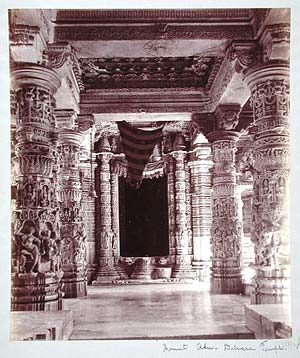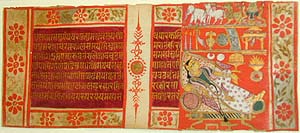| The Realm of Kings | The Temple and Sacred Text | Krishna | Rama | Devi | Shiva | Saints and Sadhus | The Realm of Gods | |||||||||||

Dilwara Temple, Mount Abu
Mount Abu, Rajasthan; ca. 1870s Albumen silver print Metropolitan Museum of Art, New York, Gift of Cynthia Hazen Polsky (MMA-2001.624.3)

The fourteen dreams of Queen Trishala
From a manuscript of the Kalpasutra Jaunpur, Eastern Uttar Pradesh; mid-15th century Opaque watercolor with gold on paper Cynthia Hazen Polsky Collection (9000-IP) |
The Temple and Sacred Text Ranging from wayside shrines to huge building complexes covered with sculptures and enclosed by walled courtyards with imposing gateways, the Hindu temple is the abode of a deity, the meeting-place between the worlds of men and the gods. Devotees visit the temple above all for vision (darshan) of the deity, especially through beholding the eyes of the divine image. Jain temples, which include some of the most intricately carved interiors in India, have much in common with their Hindu counterparts. For Jain, Hindu, and Buddhist faithful, the commissioning of opulent religious manuscripts for the use of temples and monks was auspicious and an act of merit. Following the arrival of large numbers of Muslims to India, the illustrated religious texts were among the best ways to preserve religious traditions. When the British first came to India, they were utterly entranced by Indian temple architecture. As seen here, some of the most popular subjects for early British photographers on their tour of India were scenes and subjects related to temples. |